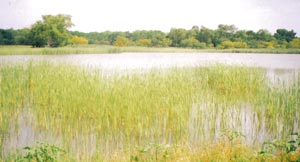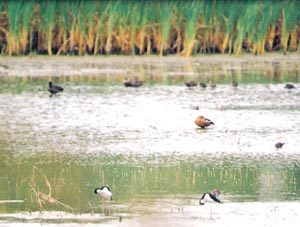Santa Ana National Wildlife Refuge
We started with five Swainson's Hawks heading north, an American Purple Gallinule and a Brown-crested Flycatcher. As we watched the flycatcher Trevor excitedly whispered 'There's a raptor over here'. We all looked skywards only to be told something like 'No, on the ground, right in front of us, in front of that bush'. I looked and couldn't see anything but Trevor was most insistent. A small movement to the left and I could see the bird: it was a young Harris's Hawk with a dead Eastern Cottontail rabbit. The bird had rabbit intenstines wrapped around part of its head! It was only about two metres away from us! We moved closer and it seemed determined not to lose it's prey and just either glared at us or tried to drag the rabbit into deeper scrub. We all (including a group of school children) watched the bird moving slowly away then left it alone.
As we walked through the woods we had Black-crested Titmouse and Golden-fronted and Ladder-backed Woodpeckers, and plenty of singing Olive Sparrows. At one point Vaughan and I suddenly got on the same bird and shouted 'Clay-colored Robin'. The bird of course flew but not too far and it and it's mate proceeded to show well a few metres away from us in a tree where they appeared to have a nest. The miss at Anzalduas became just a dim memory as we watched these surprisingly-attractive birds.

Lake at Santa Ana
As we reached the reed-fringed lakes we began to get birds more associated with water: Soras were heard as was Common Yellowthroat. On the water itself were five Neotropic Cormorants, five Anhingas, including some juveniles, American Coot, two Mottled Duck, seven Blue-winged Teal, four Pied-billed Grebes while two Forster's Terns hawked over the water. Nearby trees held three Altamira Orioles and Great-tailed Grackles. Both Great Blue Heron and Great Egret flew over the lakes.
A smaller lake, with a greater edging of reeds, yielded singing Marsh Wren, our first Green Heron, two pairs of Ruddy Duck and Moorhens. Another even smaller pool added Belted Kingfisher flying past and an adult and a juvenile Yellow-crowned Night-heron.
A third lake, by far the largest, was quiet except for a pair of Green Kingfishers flying away from us and a rather distant hovering White-tailed Kite.
Back where the Marsh Wren was singing an attempt was made to actually see the bird. As she searched the reeds Helen found a close Least Bittern – least is a good word for this bird – for a bittern it's tiny. Behind us at this point was another reedy area where we found a Sora swiming across an openish patch.

Shallow lake at Santa Ana
A bit of a walk was called for now as we headed into the woods again aiming for an area of much shallower water. This area had lots of birds: our first Fulvous Whistling-ducks (30+), Black-necked Stilt, Short-billed Dowitcher, Solitary, Least and Pectoral Sandpipers, two male Cinnamon Teal, Northern Pintail, two Mottled Duck, a pair of Gadwall, two White-faced Ibis and a Little Blue Heron.

